Impact of Aerosol Property on the Accuracy of a CO2 Retrieval Algorithm from Satellite Remote Sensing
Abstract
:1. Introduction
2. Retrieval Algorithm
2.1. State Vectors
2.2. Forward Model
2.3. Inverse Model
3. Retrieval Sensitivity Results Using Simulated Spectra
3.1. Simulations of TANSO-FTS Spectra
3.2. XCO2 Retrieval Errors and Averaging Kernels
3.3. The Sensitivity of XCO2 Retrieval Errors to State Vector Elements
4. Preliminary Validation of XCO2 Retrieved from GOSAT Spectra
4.1. Retrieval Conditions
4.2. Comparison of Ground-Based FTS Data and XCO2 Retrievals
5. Summary and Conclusion
Acknowledgments
Author Contributions
Conflicts of Interest
References
- Stocker, T.F.; Qin, D.; Plattner, G.-K.; Tignor, M.; Allen, S.K.; Boschung, J.; Nauels, A.; Xia, Y.; Bex, V.; Midgley, P.M. Climate Change 2013. The Physical Science Basis; Working Group I Contribution to the Fifth Assessment Report of the Intergovernmental Panel on Climate Change; Cambridge University Press: Cambridge, UK, 2013. [Google Scholar]
- Friedlingstein, P.; Meinshausen, M.; Arora, V.K.; Jones, C.D.; Anav, A.; Liddicoat, S.K.; Knutti, R. Uncertainties in CMIP5 climate projections due to carbon cycle feedbacks. J. Clim. 2014, 27, 511–526. [Google Scholar] [CrossRef]
- Rayner, P.J.; O’Brien, D.M. The utility of remotely sensed CO2 concentration data in surface source inversions. Geophys. Res. Lett. 2001, 28, 175–178. [Google Scholar] [CrossRef]
- Crevoisier, C.; Heilliette, S.; Chédin, A.; Serrar, S.; Armante, R.; Scott, N.A. Midtropospheric CO2 concentration retrieval from AIRS observations in the tropics. Geophys. Res. Lett. 2004, 31. [Google Scholar] [CrossRef]
- Buchwitz, M.; De Beek, R.; Noël, S.; Burrows, J.P.; Bovensmann, H.; Schneising, O.; Khlystova, I.; Bruns, M.; Bremer, H.; Bergamaschi, P.; et al. Atmospheric carbon gases retrieved from SCIAMACHY by WFM-DOAS: version 0.5 CO and CH4 and impact of calibration improvements on CO2 retrieval. Atmos. Chem. Phys. 2006, 6, 2727–2751. [Google Scholar] [CrossRef]
- Barkley, M.P.; Friess, U.; Monks, P.S. Measuring atmospheric CO2 from space using Full Spectral Initiation (FSI) WFM-DOAS. Atmos. Chem. Phys. 2006, 6, 3517–3534. [Google Scholar] [CrossRef]
- Bösch, H.; Toon, G.C.; Sen, B.; Washenfelder, R.A.; Wennberg, P.O.; Buchwitz, M.; De Beek, R.; Burrows, J.P.; Crisp, D.; Christi, M.; et al. Space-based near-infrared CO2 measurements: Testing the Orbiting Carbon Observatory retrieval algorithm and validation concept using SCIAMACHY observations over Park Falls, Wisconsin. J. Geophys. Res. 2006, 111. [Google Scholar] [CrossRef]
- Yokota, T.; Yoshida, Y.; Eguchi, N.; Ota, Y.; Tanaka, T.; Watanabe, H.; Maksyutov, S. Global concentrations of CO2 and CH4 retrieved from GOSAT: First preliminary results. SOLA 2009, 5, 160–163. [Google Scholar] [CrossRef]
- Kuze, A.; Suto, H.; Nakajima, M.; Hamazaki, T. Thermal and near infrared sensor for carbon observation Fourier-transform spectrometer on the Greenhouse Gases Observing Satellite for greenhouse gases monitoring. Appl. Opt. 2009, 48, 6716–6733. [Google Scholar] [CrossRef] [PubMed]
- Yoshida, Y.; Ota, Y.; Eguchi, N.; Kikuchi, N.; Nobuta, K.; Tran, H.; Morino, I.; Yokota, T. Retrieval algorithm for CO2 and CH4 column abundances from short-wavelength infrared spectral observations by the Greenhouse gases observing satellite. Atmos. Meas. Tech. 2011, 4, 717–734. [Google Scholar] [CrossRef]
- Bril, A.; Oshchepkov, S.; Yokota, T.; Inoue, G. Parameterization of aerosol and cirrus cloud effects on reflected sunlight spectra measured from space: Application of the equivalence theorem. Appl. Opt. 2007, 46, 2460–2470. [Google Scholar] [CrossRef] [PubMed]
- Oshchepkov, S.; Bril, A.; Yokota, T. PPDF-based method to account for atmospheric light scattering in observations of carbon dioxide from space. J. Geophys. Res. 2008, 113. [Google Scholar] [CrossRef]
- Oshchepkov, S.; Bril, A.; Yokota, T. An improved photon path length probability density function–based radiative transfer model for space-based observation of greenhouse gases. J. Geophys. Res. 2009, 114, D19207. [Google Scholar] [CrossRef]
- Oshchepkov, S.; Bril, A.; Maksyutov, S.; Yokota, T. Detection of optical path in spectroscopic space-based observations of greenhouse gases: Application to GOSAT data processing. J. Geophys. Res. 2011, 116, D14304. [Google Scholar] [CrossRef]
- Crisp, D.; Fisher, B.; O’Dell, C.; Frankenberg, C.; Basilio, R.; Bosch, H.; Brown, L.R.; Castano, R.; Connor, B.; Deutscher, N.M.; et al. The ACOS CO2 retrieval algorithm-Part II: Global XCO2 data characterization. Atmos. Meas. Tech. 2012, 5, 687–707. [Google Scholar] [CrossRef]
- O’Dell, C.W.; Connor, B.; Bösch, H.; O’Brien, D.; Frankenberg, C.; Castano, R.; Christi, M.; Eldering, D.; Fisher, B.; Gunson, M.; et al. The ACOS CO2 retrieval algorithm–Part 1: Description and validation against synthetic observations. Atmos. Meas. Tech. 2012, 5, 99–121. [Google Scholar] [CrossRef]
- Boesch, H.; Baker, D.; Connor, B.; Crisp, D.; Miller, C. Global characterization of CO2 column retrievals from shortwave-infrared satellite observations of the Orbiting Carbon Observatory-2 mission. Remote Sens. 2011, 3, 270–304. [Google Scholar] [CrossRef]
- Connor, B.J.; Boesch, H.; Toon, G.; Sen, B.; Miller, C.; Crisp, D. Orbiting Carbon Observatory: Inverse method and prospective error analysis. J. Geophys. Res. 2008, 113. [Google Scholar] [CrossRef]
- Butz, A.; Hasekamp, O.; Frankenberg, C.; Aben, I. Retrievals of atmospheric CO2 from simulated space-borne measurements of backscattered near-infrared sunlight: Accounting for aerosol effects. Appl. Opt. 2009, 48, 3322–3336. [Google Scholar] [CrossRef] [PubMed]
- Butz, A.; Hasekamp, O.; Frankenberg, C.; Vidot, J.; Aben, I. CH4 retrievals from space-based solar backscatter measurements: Performance evaluation against simulated aerosol and cirrus loaded scenes. J. Geophys. Res. 2010, 115. [Google Scholar] [CrossRef]
- Butz, A.; Guerlet, S.; Hasekamp, O.; Schepers, D.; Galli, A.; Aben, I.; Frankenberg, C.; Hartmann, J.M.; Tran, H.; Kuze, A.; et al. Toward accurate CO2 and CH4 observations from GOSAT. Geophys. Res. Lett. 2011, 38, L14812. [Google Scholar] [CrossRef]
- Heymann, J.; Reuter, M.; Hilker, M.; Buchwitz, M.; Schneising, O.; Bovensmann, H.; Burrows, J.; Kuze, A.; Suto, H.; Deutscher, N.M.; et al. Consistent satellite XCO2 retrievals from SCIAMACHY and GOSAT using the BESD algorithm. Atmos. Meas. Tech. 2015, 8, 2961–2980. [Google Scholar] [CrossRef]
- Rodgers, C.D. Inverse Methods for Atmospheric Sounding: Theory and Practice, 2nd ed.; World Scientific Publishig Co. Pte. Ltd.: Singapore, 2000. [Google Scholar]
- Oshchepkov, S.; Bril, A.; Yokota, T.; Morino, I.; Yoshida, Y.; Matsunaga, T.; Belikov, D.; Wunch, D.; Wennberg, P.; Toon, G.; et al. Effects of atmospheric light scattering on spectroscopic observations of greenhouse gases from space: Validation of PPDF-based CO2 retrievals from GOSAT. J. Geophys. Res. 2012, 117, D12305. [Google Scholar] [CrossRef]
- O’Brien, D.M.; Rayner, P.J. Global observations of the carbon budget, 2, CO2 column from differential absorption of reflected sunlight in the 1.61 μm band of CO2. J. Geophys. Res. 2002, 107, 4354. [Google Scholar] [CrossRef]
- Carbon Tracker-Asia Webpage. Available online: http://www.nimr.go.kr/2/carbontracker/index.html (accessed on 10 April 2016).
- Carbon Tracker Webpage. Available online: http://www.esrl.noaa.gov/gmd/ccgg/carbontracker/ (accessed on 10 April 2016).
- Hong, S.-Y.; Noh, Y.; Dudhia, J. A new vertical diffusion package with an explicit treatment of entrainment processes. Mon. Weather Rev. 2006, 134, 2318–2341. [Google Scholar] [CrossRef]
- Salstein, D.A.; Ponte, R.M.; Cady-Pereira, K. Uncertainties in atmospheric surface pressure fields from global analyses. J. Geophys. Res. 2008, 113. [Google Scholar] [CrossRef]
- Dubovik, O.; King, M.D. A flexible inversion algorithm for retrieval of aerosol optical properties from Sun and sky radiance measurements. J. Geophys. Res. 2000, 105, 20673–20696. [Google Scholar] [CrossRef]
- Kim, J.; Lee, J.; Lee, H.C.; Higurashi, A.; Takemura, T.; Song, C.H. Consistency of the aerosol type classification from satellite remote sensing during the Atmospheric Brown Cloud–East Asia Regional Experiment campaign. J. Geophys. Res. 2007, 112, D22S33. [Google Scholar] [CrossRef]
- Lee, J.; Kim, J.; Song, C.; Kim, S.; Chun, Y.; Sohn, B.; Holben, B. Characteristics of aerosol types from AERONET sunphotometer measurements. Atmos. Environ. 2010, 44, 3110–3117. [Google Scholar] [CrossRef]
- Spurr, R.J. VLIDORT: A linearized pseudo-spherical vector discrete ordinate radiative transfer code for forward model and retrieval studies in multilayer multiple scattering media. J. Quant. Spectrosc. Radiat. Transf. 2006, 102, 316–342. [Google Scholar] [CrossRef]
- Crisp, D.; Bösch, H.; Brown, L.; Castano, R.; Christi, M.; Connor, B.; Frankenberg, C.; McDuffie, J.; Miller, C.; Natraj, V. OCO (Orbiting Carbon Observatory)-2 Level 2 Full Physics Retrieval Algorithm Theoretical Basis. Available online: http://disc.sci.gsfc.nasa.gov/acdisc/documentation/OCO-2_L2_FP_ATBD_v1_rev4_Nov10.pdf (accessed on 10 November 2010).
- Payne, V.; Thompson, D. Spectroscopic needs for OCO-2. Available online: https://oco.jpl.nasa.gov/files/ocov2/OCO-2_spectroscopic_needs_20132.pdf (accessed on 3 December 2013).
- Tran, H.; Hartmann, J. An improved O2 A band absorption model and its consequences for retrievals of photon paths and surface pressures. J. Geophys. Res. 2008, 113, D18104. [Google Scholar] [CrossRef]
- Bodhaine, B.A.; Wood, N.B.; Dutton, E.G.; Slusser, J.R. On Rayleigh optical depth calculations. J. Atmos. Ocean. Technol. 1999, 16, 1854–1861. [Google Scholar] [CrossRef]
- Thuillier, G.; Herse, M.; Labs, S.; Foujols, T.; Peetermans, W.; Gillotay, D.; Simon, P.C.; Mandel, H. The solar spectral irradiance from 200 to 2400 nm as measured by the SOLSPEC Spectrometer from the ATLAS 123 and EURECA missions. Sol. Phys. 2003, 214, 1–22. [Google Scholar] [CrossRef]
- Baldridge, A.; Hook, S.; Grove, C.; Rivera, G. The ASTER spectral library version 2.0. Remote Sens. Environ. 2009, 113, 711–715. [Google Scholar] [CrossRef]
- Kahn, R.; Banerjee, P.; McDonald, D. Sensitivity of multiangle imaging to natural mixtures of aerosols over ocean. J. Geophys. Res. 2001, 106, 18219–18238. [Google Scholar] [CrossRef]
- Yoshida, Y.; Kikuchi, N.; Yokota, T. On-orbit radiometric calibration of SWIR bands of TANSO-FTS onboard GOSAT. Atmos. Meas. Tech. 2012, 5, 2515–2523. [Google Scholar] [CrossRef]
- Kuze, A.; Taylor, T.E.; Kataoka, F.; Bruegge, C.J.; Crisp, D.; Harada, M.; Helmlinger, M.; Inoue, M.; Kawakami, S.; Kikuchi, N. Long-term vicarious calibration of GOSAT short-wave sensors: Techniques for error reduction and new estimates of radiometric degradation factors. IEEE Trans. Geosci. Remote Sens. 2014, 52, 3991–4004. [Google Scholar] [CrossRef]
- Kuze, A.; Suto, H.; Shiomi, K.; Urabe, T.; Nakajima, M.; Yoshida, J.; Kawashima, T.; Yamamoto, Y.; Kataoka, F.; Buijs, H. Level 1 algorithms for TANSO on GOSAT: Processing and on-orbit calibrations. Atmos. Meas. Tech. 2012, 5, 2447–2467. [Google Scholar] [CrossRef]
- Suto, H.; Kuze, A.; Shiomi, K.; Nakajima, M. Updated level-1 processing after two-years operation of TANSO-FTS. Proc. SPIE 2011. [Google Scholar] [CrossRef]
- Yoshida, Y.; Kikuchi, N.; Morino, I.; Uchino, O.; Oshchepkov, S.; Bril, A.; Saeki, T.; Schutgens, N.; Toon, G.; Wunch, D. Improvement of the retrieval algorithm for GOSAT SWIR XCO2 and XCH4 and their validation using TCCON data. Atmos. Meas. Tech. 2013, 6, 1533–1547. [Google Scholar] [CrossRef]
- Wunch, D.; Toon, G.C.; Wennberg, P.O.; Wofsy, S.C.; Stephens, B.B.; Fischer, M.L.; Uchino, O.; Abshire, J.B.; Bernath, P.; Biraud, S.C.; et al. Calibration of the Total Carbon Column Observing Network using aircraft profile data. Atmos. Meas. Tech. 2010, 3, 1351–1362. [Google Scholar] [CrossRef]
- Toon, G.; Farmer, C.; Schaper, P.; Lowes, L.; Norton, R. Composition measurements of the 1989 Arctic winter stratosphere by airborne infrared solar absorption spectroscopy. J. Geophys. Res. 1992, 97, 7939–7961. [Google Scholar] [CrossRef]
- Wunch, D.; Toon, G.C.; Blavier, J.-F.L.; Washenfelder, R.A.; Notholt, J.; Connor, B.J.; Griffith, D.W.; Sherlock, V.; Wennberg, P.O. The total carbon column observing network. Philos. Trans. R. Soc. A 2011, 369, 2087–2112. [Google Scholar] [CrossRef] [PubMed]
- Morino, I.; Uchino, O.; Inoue, M.; Yoshida, Y.; Yokota, T.; Wennberg, P.; Toon, G.; Wunch, D.; Roehl, C.; Notholt, J.; et al. Preliminary validation of column-averaged volume mixing ratios of carbon dioxide and methane retrieved from GOSAT short-wavelength infrared spectra. Atmos. Meas. Tech. 2010, 4, 1061–1076. [Google Scholar] [CrossRef]
- Guerlet, S.; Butz, A.; Schepers, D.; Basu, S.; Hasekamp, O.; Kuze, A.; Yokota, T.; Blavier, J.F.; Deutscher, N.; Griffith, D.T.; et al. Impact of aerosol and thin cirrus on retrieving and validating XCO2 from GOSAT shortwave infrared measurements. J. Geophys. Res. 2013, 118, 4887–4905. [Google Scholar] [CrossRef]

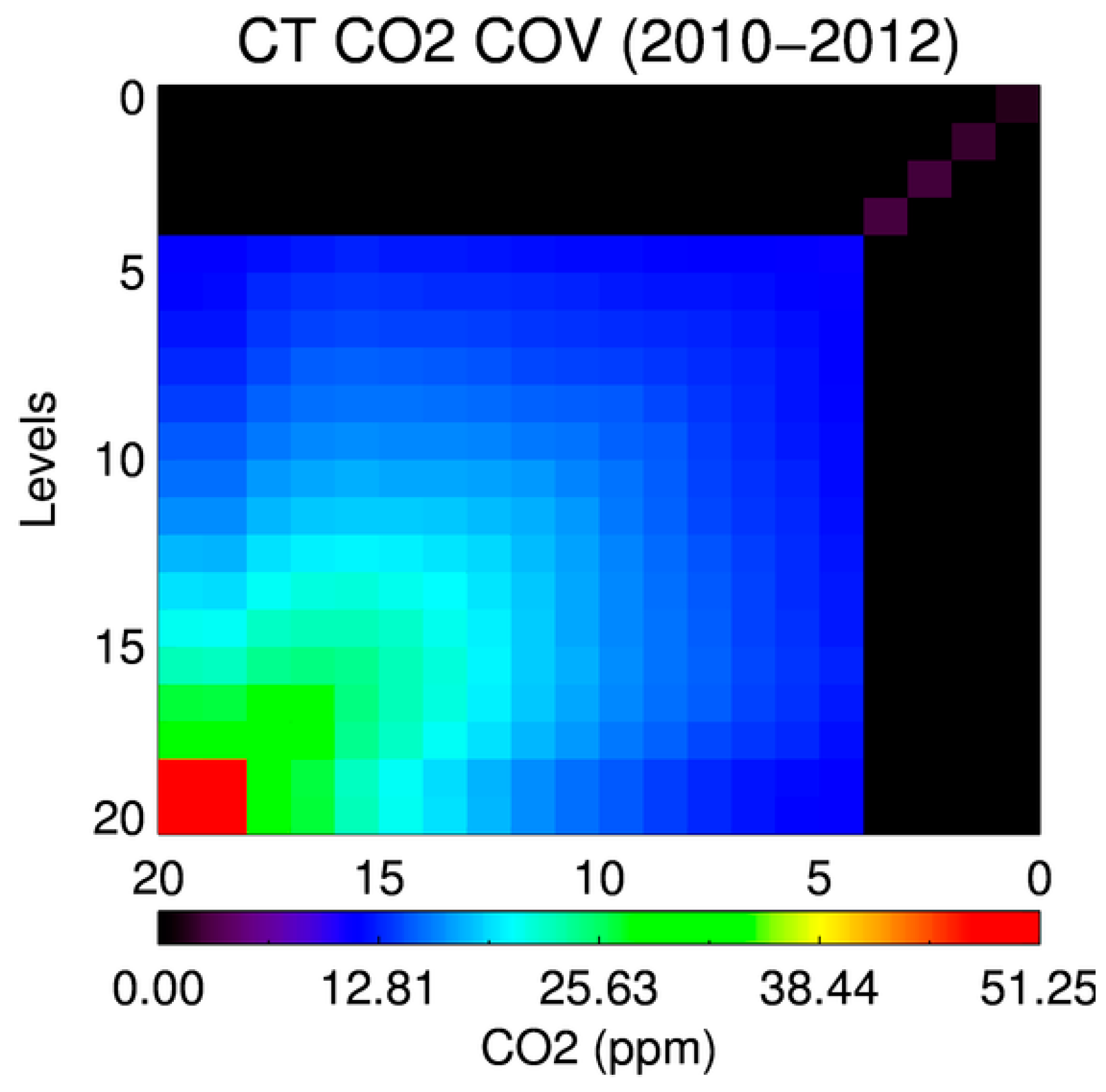
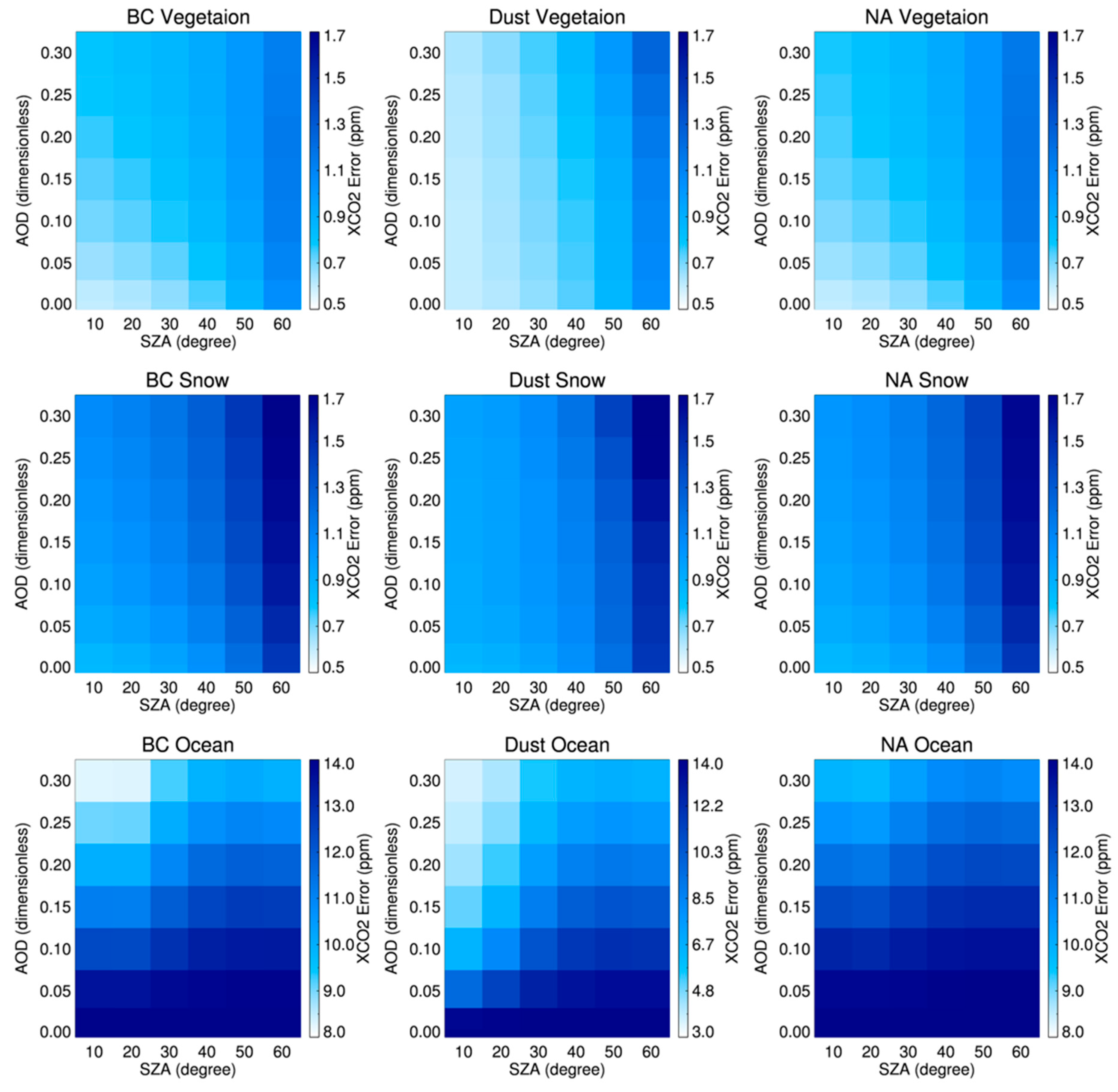

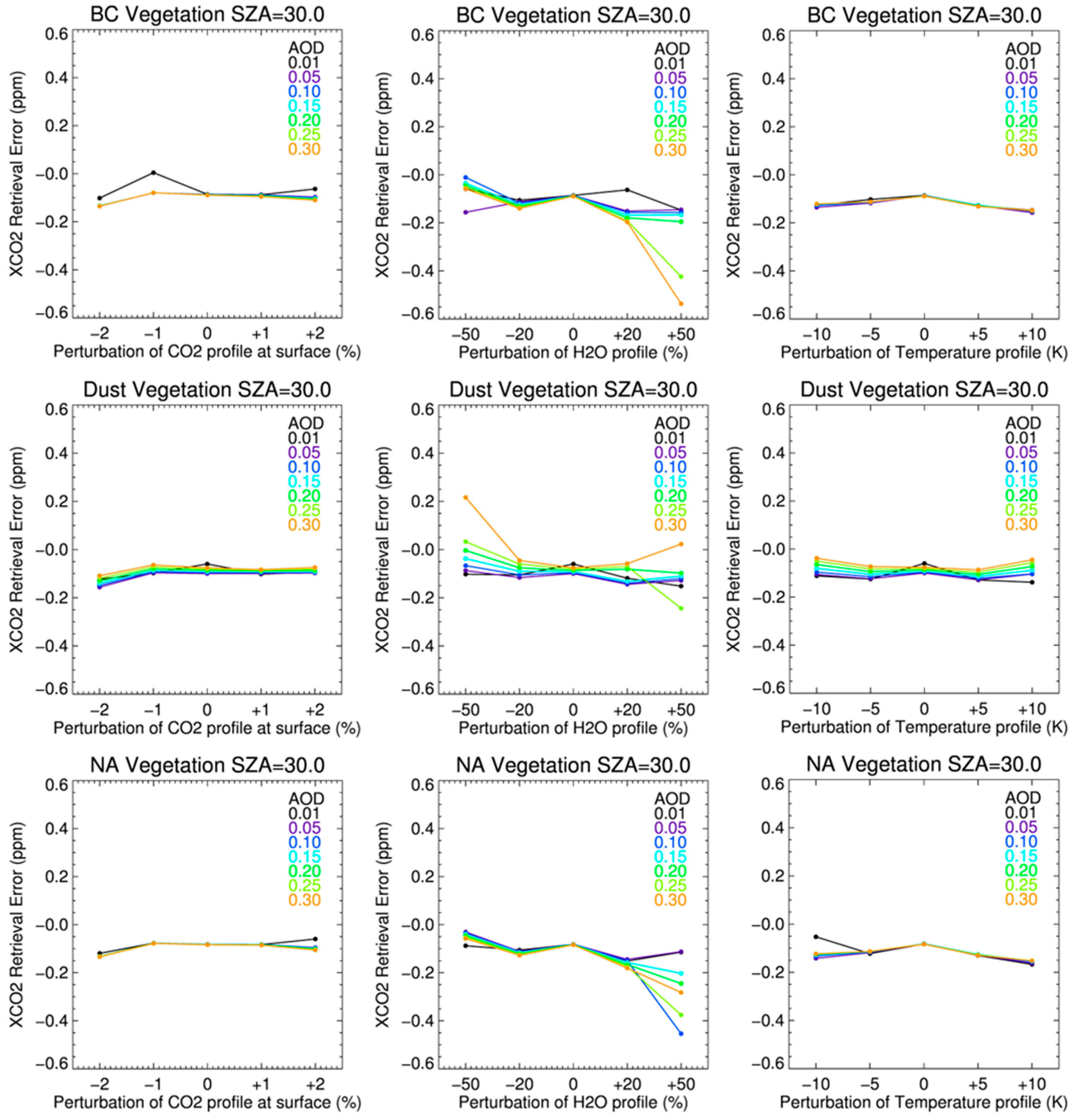
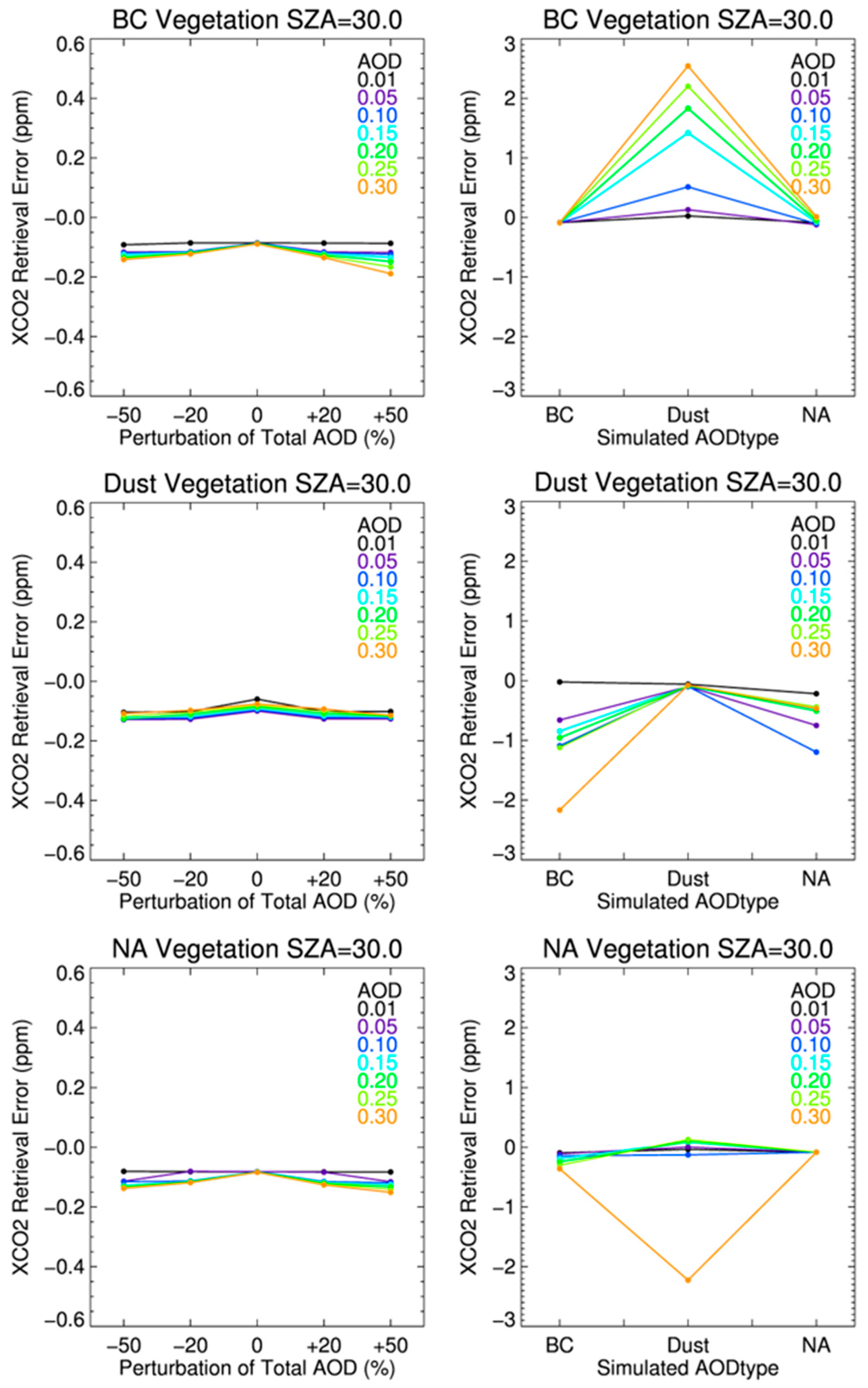
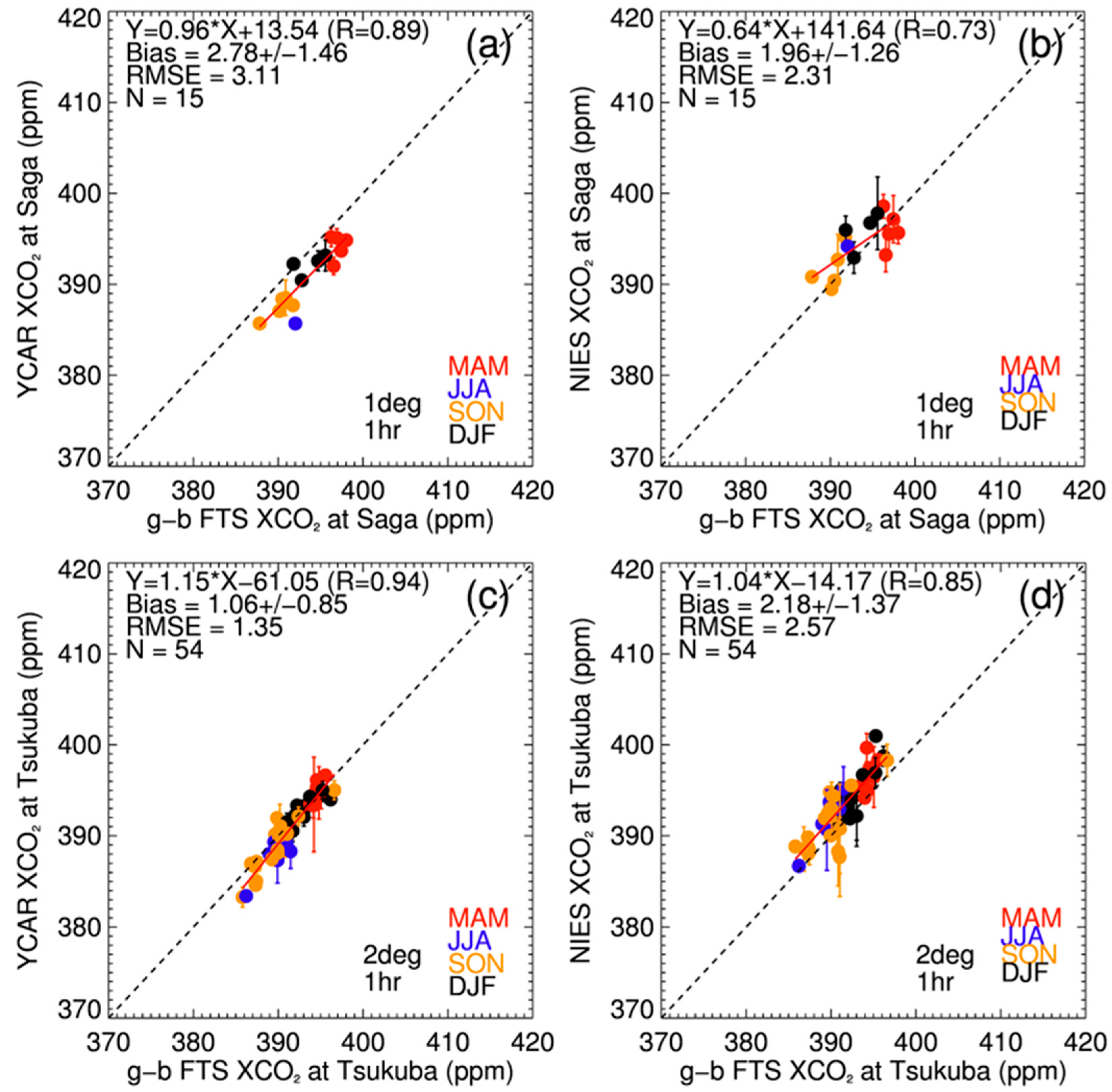
| Band Number | Spectral Range | Number of Channels |
|---|---|---|
| 1 | 12,950–13,200.6 cm−1 (0.757–0.772 μm) | 1256 |
| 2 | 6161.0–6297.4 cm−1 (1.588–1.623 μm) | 684 |
| 3 | 4800.0–4902.2 cm−1 (2.040–2.083 μm) | 512 |
| Name | Quantity | Description | A Priori | A Priori 1-σ Error |
|---|---|---|---|---|
| CO2 | 20 levels | Volume mixing ratio on each level | Carbon Tracker-Asia | Fixed matrix as seen in Figure 2 |
| H2O | 1 | Multiplier to a priori profile | ECMWF | 0.5 |
| Temperature | 1 | Offset to a priori profile | ECMWF | 5 K |
| Aerosols | 19 layers (3 types) | AOD profiles on each level for user-defined types | Constant | 0.5 of a priori profiles |
| Surface albedo | 3 bands × 2 variables | Albedo at band centre | From spectrum | 1 |
| Albedo slope | 0.0005/cm−1 | |||
| Wavenumber | 3 bands × 2 variables | Wavenumber shift | From spectrum | 1 cm−1 |
| Wavenumber squeeze | 1.0 × 10−5 cm−1 |
| Aerosol Type | r m1 | rm2 | σm1 | σm2 | FMF | nreal | nimg |
|---|---|---|---|---|---|---|---|
| BC | 0.076 | 0.624 | 1.677 | 2.008 | 0.999 | 1.486 | 0.010 |
| Dust | 0.041 | 1.103 | 2.370 | 1.647 | 0.995 | 1.546 | 0.002 |
| NA | 0.088 | 0.664 | 1.777 | 1.955 | 0.999 | 1.426 | 0.004 |
| Parameter | Range |
|---|---|
| Total AOD | 0.01, 0.05, 0.10, 0.15, 0.20, 0.25, 0.30 |
| Solar zenith angle | 10, 20, 30, 40, 50, 60 |
| Surface type | Vegetation, Snow, ocean |
| State Vector | BC | Dust | NA | ||||
|---|---|---|---|---|---|---|---|
| Aerosol Type | |||||||
| Variables | Errors | Min. | Max. | Min. | Max. | Min. | Max. |
| CO2 | ±1%–2% (±~4–8 ppm) | −0.135 | −0.079 | −0.156 | −0.064 | −0.134 | −0.077 |
| H2O | ±20%–50% | −0.537 | −0.011 | −0.244 | 0.216 | −0.454 | −0.031 |
| Temperature | ±10 K | −0.158 | −0.086 | −0.128 | −0.038 | −0.163 | −0.082 |
| AOD | ±20%–50% | −0.189 | −0.086 | −0.129 | −0.076 | −0.151 | −0.081 |
| Aerosol type | BC, dust, NA | −0.121 | 2.544 | −2.167 | −0.076 | −2.225 | 0.129 |
| Site | Country | Location | Altitude (m) |
|---|---|---|---|
| Saga | Japan | 33.24°N, 130.29°E | 7 |
| Tsukuba | Japan | 36.05°N, 140.12°E | 31 |
© 2016 by the authors; licensee MDPI, Basel, Switzerland. This article is an open access article distributed under the terms and conditions of the Creative Commons by Attribution (CC-BY) license (http://creativecommons.org/licenses/by/4.0/).
Share and Cite
Jung, Y.; Kim, J.; Kim, W.; Boesch, H.; Lee, H.; Cho, C.; Goo, T.-Y. Impact of Aerosol Property on the Accuracy of a CO2 Retrieval Algorithm from Satellite Remote Sensing. Remote Sens. 2016, 8, 322. https://doi.org/10.3390/rs8040322
Jung Y, Kim J, Kim W, Boesch H, Lee H, Cho C, Goo T-Y. Impact of Aerosol Property on the Accuracy of a CO2 Retrieval Algorithm from Satellite Remote Sensing. Remote Sensing. 2016; 8(4):322. https://doi.org/10.3390/rs8040322
Chicago/Turabian StyleJung, Yeonjin, Jhoon Kim, Woogyung Kim, Hartmut Boesch, Hanlim Lee, Chunho Cho, and Tae-Young Goo. 2016. "Impact of Aerosol Property on the Accuracy of a CO2 Retrieval Algorithm from Satellite Remote Sensing" Remote Sensing 8, no. 4: 322. https://doi.org/10.3390/rs8040322
APA StyleJung, Y., Kim, J., Kim, W., Boesch, H., Lee, H., Cho, C., & Goo, T.-Y. (2016). Impact of Aerosol Property on the Accuracy of a CO2 Retrieval Algorithm from Satellite Remote Sensing. Remote Sensing, 8(4), 322. https://doi.org/10.3390/rs8040322








